Last Chance: The Annual Orchid Show Soars at the New York Botanical Garden
The vibrant colors of Mexico come to NYC for a unique Orchid Show at NYBG!


Located about an hour north of New York City, Donald J. Trump State Park is an enigmatic destination emblazoned on several signs along the Taconic Parkway. On Election Day, as a distraction from the relentless news cycle, we decided to take a trip to check out what’s there. For the most part, it’s full of a whole lot of nothing. In fact, officially it’s been closed since 2010. It is not even listed as a park on the official website for New York State Parks, Recreation and Preservation. “From the shores of Long Island to the mighty Niagara Falls, New York’s 180 state parks offer countless opportunities to explore your natural environment,” the New York State Parks website boasts, but the alphabetical dropdown of all the parks goes from Dewolfe Point State Park to Eel Weir State Park with no mention of Donald J. Trump State Park.
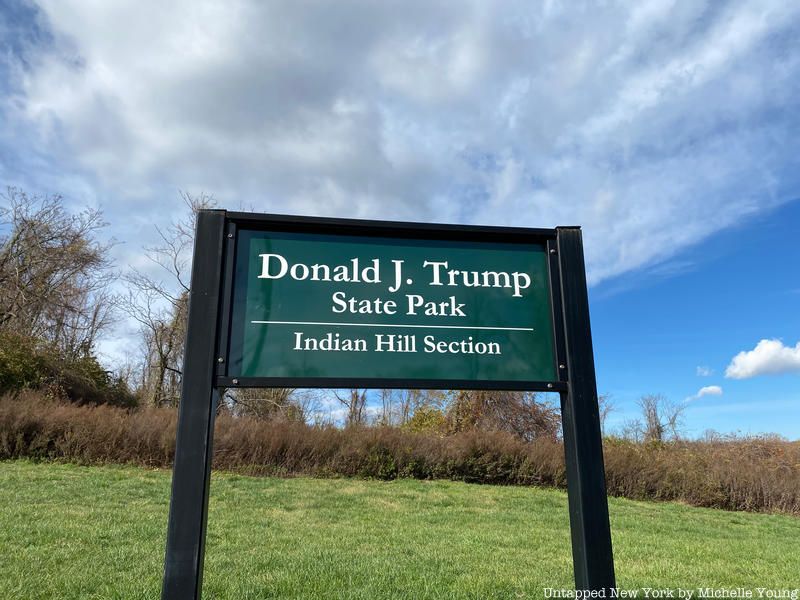
The park is technically split into two separate parcels: the northern “Indian Hill Section” located in Jefferson Valley (part of Yorktown) is the larger of the two at 282 acres. The “French Hill Section,” located about seven miles south in Yorktown Heights, is 154 aces. The park was born of a tax write-off on land Donald Trump had purchased in 1998 for $2.5 million — $1.75 for the Indian Hill section and $750,000 for the French Hill section — that he hoped to turn into a championship golf course. Trump said publicly that the land was worth $100 million, since the zoning permitted residential development.
The Guardian reports that if Trump indeed claimed a tax deduction of $100 million, it would be “an amount that, if claimed as a qualified conservation contribution, could have saved him a fortune in income tax, potentially carried forward for years.” Another possible figure is $26.1 million, a value for the park land released by the Trump campaign in 2016 within a list of Trump charitable donations. It is his second largest charitable donation on the list, trumped only by the line entry “conservation easements on various properties.” It’s also possible that $26.1 million is the carry forward amount, as the donation took place in 2006 but was listed by the Trump campaign as a charitable contribution in the 2010-2014 time frame.
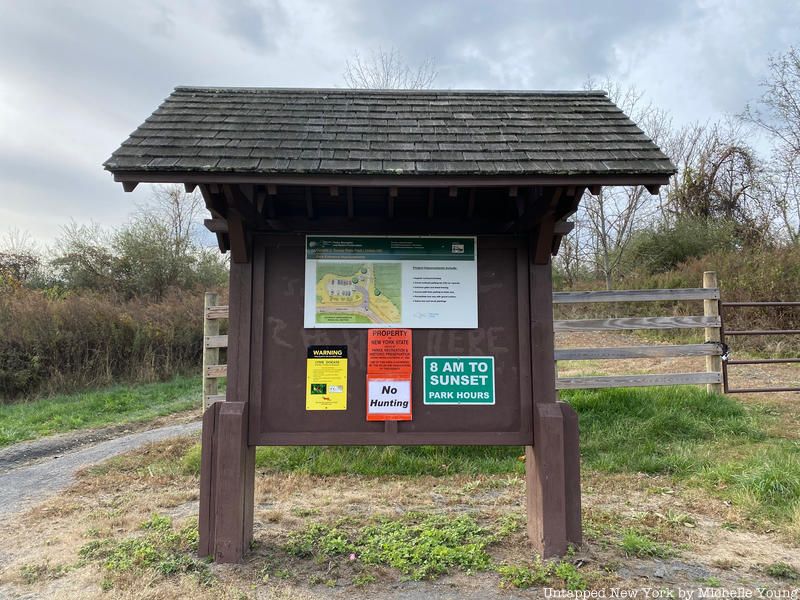
Size wise, Donald J. Trump Park is slightly larger than the new Shirley Chisholm State Park in Queens (407 acres) and slightly smaller than Trail View State Park (454 acres) which extends across both Nassau and Suffolk counties on Long Island. The park is also situated in the New York City watershed zone, just a few miles far from the Croton Reservoir which supplies drinking water to the city.
According to The New York Times, “in 2002, Mr. Trump withdrew plans to build a $10 million private golf course on land that included significant portions of wetlands, after encountering strict environmental restrictions and permitting requirements. He blamed the Yorktown supervisor, Linda Cooper, for thwarting his plans, telling her in a letter that she had ‘done a terrible disservice’ to her constituents.” Ms. Cooper countered in the Times, saying “that Mr. Trump ‘just didn’t want to go through the rules. He called me, at one point and said, ‘Linda, just let me build the golf course — I’m rich, you’ll like it.'” Instead, Trump donated the land to New York State in 2006 while George Pataki was governor.
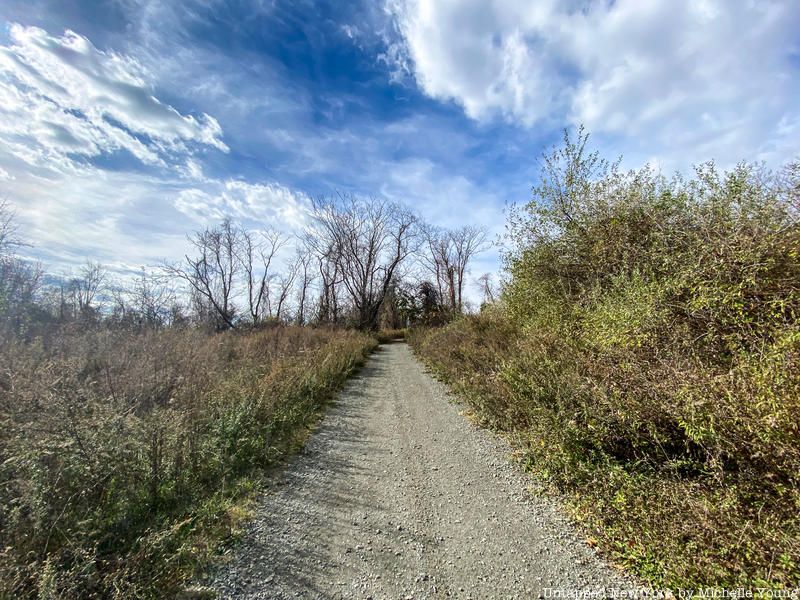
For New York State, the donation offered a win for land preservation and accessible public space for the region. Pataki had committed to opening or expanding 25 parks within five years of his 2004 State of the State Address. The sub-headline of the state’s press release about Trump’s donation proclaimed a “Gift of 436 Acres to Protect Open Space.” Pataki said at the time “today marks the perfect time for New Yorkers to receive such a generous and meaningful gift – the protection of valuable open space and beautiful parklands in the Hudson Valley. The establishment of Donald J. Trump State Park will increase public access to scenic landscapes and provide additional recreational opportunities for families and visitors to the region. On behalf of the people of the Empire State, I express our gratitude to Donald Trump for his vision and commitment to preserve the natural resource of this property for the benefit of future generations.”

End of the gravel path at Donald J. Trump State Park’s Indian Hill Section, which leads out into a clearing
Trump stated with his usual superlatives, “I have always loved the City and State of New York and this is my way of trying to give something back. I hope that these 436 acres of property will turn into one of the most beautiful parks anywhere in the world.” Assemblyman Will Stephens said, “This generous donation of land is a significant step toward land preservation for our region. This scenic parkland will be enjoyed by our community for many years to come.” Assemblywoman Sandra Galef said, “Parkland is such a precious commodity and this gift of 436 acres from Donald Trump will have a positive impact on the residents of our Hudson Valley communities for many decades.” State Parks Commissioner Bernadette Castro said, “This magnificent donation highlights the long-term success of fostering public/private partnerships as we continue to implement Governor Pataki’s vision for the environment and open space protection. Donald Trump’s incredible gift will have a lasting impact on our parklands, opening up public access to additional outdoor recreation and helping preserve the rich array of natural resources found in the Hudson Valley. Through his generosity, New Yorkers and their families will now be able to enjoy these parklands for years to come.”

But nearly fifteen years later, despite all the grand claims that the land would become a recreational destination for the public, little has been done with the park to make it any more than a dense cover of brush. Visitors are few and most of the plans for the park have not come to fruition. It was one of the 58 parks closed by New York State as part of a budget cut in 2010 and remains technically closed to this day. Trump threatened to take the land back in 2010 when informed of the closure, but it still belongs to New York State today. The park must always bear Trump’s name, according to the donation agreement, although Manhattan State Senator Brad Hoylman, who proposed a bill to change the name of the park in 2019, believes that the State legislature has the power to override that clause since the local community and lawmakers were not consulted. A Change.org petition was also started to advocate for the removal of Trump’s name.
As a result, Donald J. Trump Park is a seldom-visited and forgotten spot bearing the President’s name. A man we met who comes to the Indian Hill section on his lunch breaks told us that people come here “very rarely. Mostly people walking their dogs or that sort of thing. But it’s usually pretty dead.” He tells us that he’s never been inside the park himself, but comes to the parking lot to race his toy cars. Curiously however, despite the official closure of the park for over a decade, it remains accessible to the public with signage at the entrances and on the Taconic Highway.
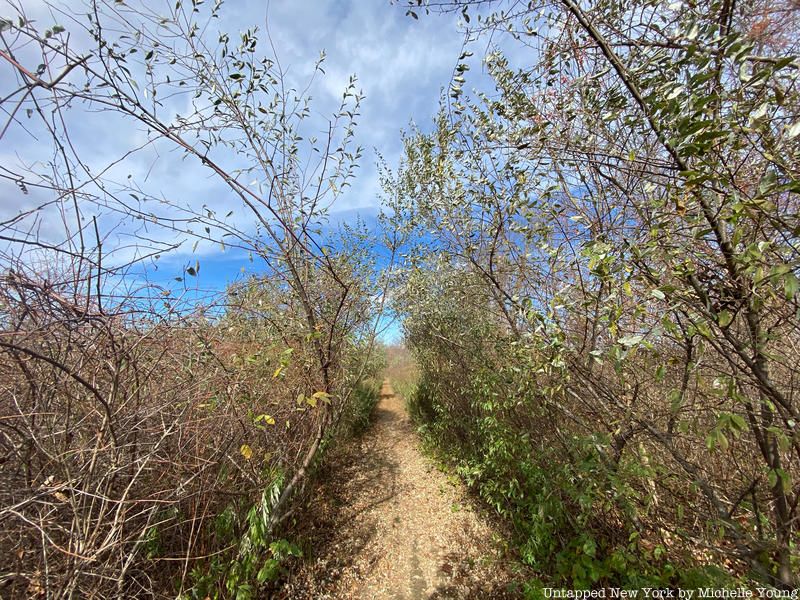
On our visit, we explored the Indian Hill section first. There are no bathrooms or any kind of amenity, not even a bench or garbage cans. There is no map of the park itself and no signs to denote the makeshift trail. The existing signage warns people not to hunt and to beware of ticks. Despite all this, we discovered that the walk along the trail was pleasant, if uneventful, and we had our lunch on the remnants of a stone wall.
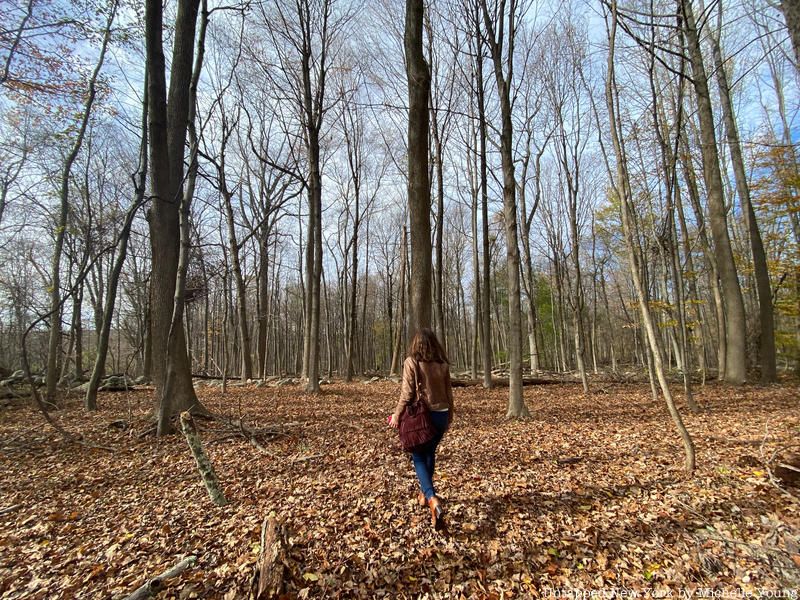
From the entrance kiosk, a gravel path leads to a small clearing. From there, you can take a weed-whacked path that, as we discovered, does go in a loop around the land. This section of the park was formerly farmland (which you can see in satellite images from the 1990s) but the farm houses and other buildings were all demolished by 2004. The trees and brush grew in rapidly after that, quite densely. According to the Friends of FDR State Park, an organization that volunteered to maintain Donald J. Trump State Park, “it’s possible to walk along rutted ATV tracks or on former farm roads” — although from what we can see on our recent visit, all of that has been overgrown at this point.

Somewhat north of the clearing, just like the famous Robert Frost poem, two paths do indeed diverge in the wood. If you go right, the path abruptly ends in the forest. If you go left, you continue on the loop. You can hear the Taconic Parkway almost everywhere you are in the park, and just as you get closest to the highway, the path becomes so overgrown you have to push through thick branches. In summer, it would be unnavigable. It felt as if we might have been the only people, besides park staff, to have gone all the way around the trail.
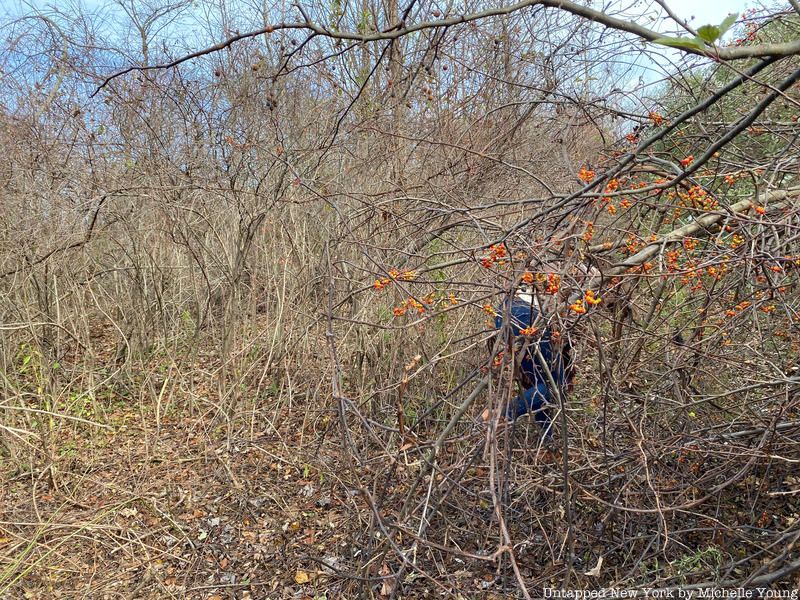

A sign on the entrance kiosk shows the latest improvements that are planned for the entrance to the park, which are essentially for basic maintenance. The parking lot will get resurfaced, a new metal gate will be installed, the wood fence will get replaced, and a short path will be built from the parking lot to the kiosk. There was one previous effort to activate the Donald J. Trump State Park: a local group advocated for over a decade from 2002 to 2012 to build a dog park in the Indian Hill section but failed due to lack of funds. According to the Yorktown Daily Voice, the group fell “short of the estimated $40,000 needed for a fence and $4,000 to remove asbestos from some dilapidated buildings on the site.” In addition, the state and the town declined to provide services for the dog park, including mowing the grass, collecting and removing garbage, plowing or repaving the road. So for now, the Indian Hill Section of Donald J. Trump Park remains a single cleared field and the unmarked trail.

Next, we headed to the French Hill Section of Donald J. Trump State Park, where we expected more of the same but found quite a hidden gem. The arrival began similarly, with the entrance to the park at the end of a residential road. We maneuvered around a large downed branch and arrived at the entrance signage and fence for the park, and then we pulled into the parking lot. The same type of park kiosk we found in the Indian Hill section is here, but in addition, there are two park benches which aren’t present in the Indian Hill Section.
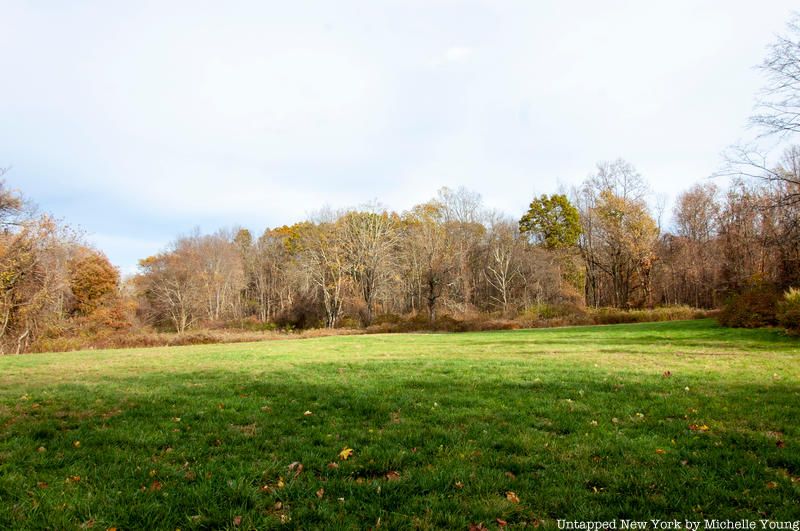
The French Hill section has a more illustrious historical connection, named for the French contingent who followed the Marquis de Lafayette to America during the American Revolution. They camped here while fighting alongside the Continental Army under General Rochambeau. According to Scenes from the Trail, “The French Army encamped twice on and around what is now French Hill in Yorktown. Once before the Battle of Yorktown, Virginia in 1781, then on their march back in 1782. They would make French Hill and Crompond their longest encampment on their return march in 1782. On October 21st, the French broke camp and marched out of Crompond never to return. Without their help the Continental Army could not have defeated the British and secured the independence of the United States of America.”

As you pass the entrance kiosk, you will see a stone wall and an intriguing stone entranceway in the distance. If you have seen as many Gilded Age mansions throughout the East Coast as we have, you’ll recognize this architectural construction almost immediately. It feels similar to the grotto at The Mount, Edith Wharton’s estate in the Berkshires. Clearly something grand was once here. Our guess at first glance was that the stone remnants were part of an enclosed garden — a hunch you will soon see we confirmed through our subsequent research.
Turns out, these are the remnants of a former 550-acre estate once known as “French Hill Farm,” owned by William Delavan Baldwin of the Otis Elevator Company. Born in 1856 in Auburn, New York, Baldwin was the descendent of an early Colonial settler to America. After high school, Baldwin worked for the farm machinery company D.M. Osborne & Co., where he became in charge of the European branch of the business by the age of 21. Baldwin shifted his attention in 1882 to the burgeoning elevator business, buying a stake in Otis Brothers & Co. It was a prescient decision, at a time “when elevators were something of a novelty,” reported The Yonkers Herald in 1930, “Buildings were not so tall then and ‘lifts’ were a luxury rather than a necessity.” Asked to serve as the company’s treasurer, Baldwin was “largely responsible for the development of the business,” stated The New York Times. Baldwin would be become one of the largest shareholders of Otis and serve as President of the company, General Manager, and Chairman of the Board.
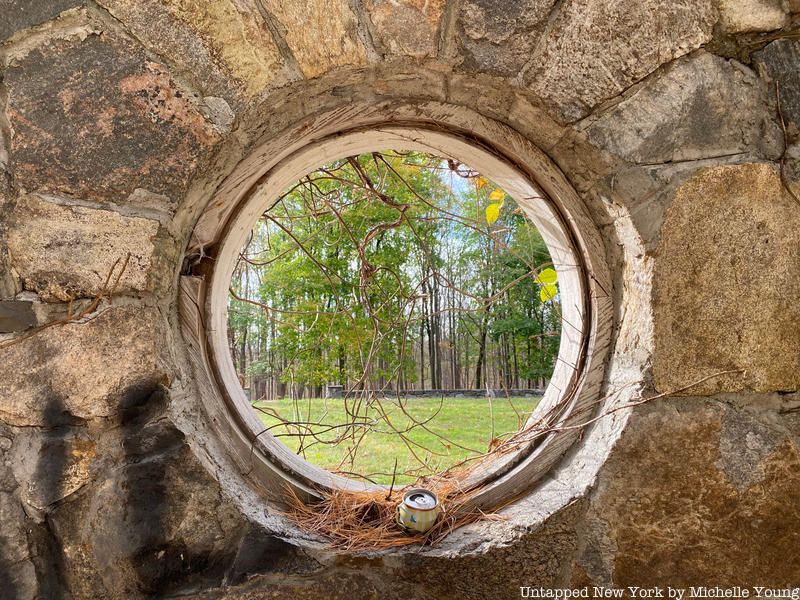
In the 1894 book, Makers of New York: An Historical Work, Giving Portraits and Sketches of the Most Eminent Citizens of New York, Baldwin’s business success is described as “due to his indomitable will and perseverance, which are distinguishing traits of his character. Personally he is courteous and affable in his intercourse with business men and friends, while no man bears a higher reputation than he for integrity just dealing.” Baldwin would also serve as the Vice President of the First National Yonkers, the director and trustee of numerous other banks and insurance companies including the United States Savings Bank, and in 1892 was nominated by the local Republican party as a candidate for U.S. Congress but declined it.
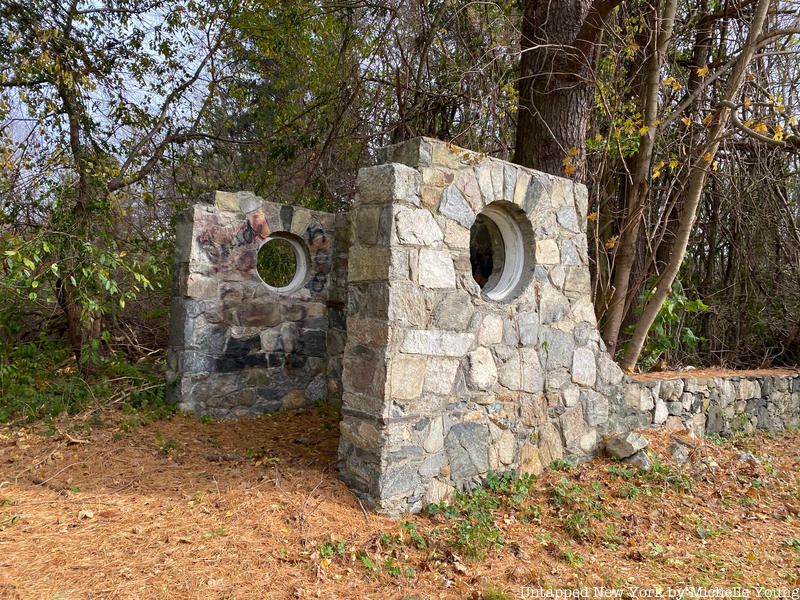
Baldwin’s wedding in 1881 to Ms. Helen Runyan of Montclair, New Jersey was called “the most brilliant social event of the season” and “the handsomest of the kind that has ever been witnessed” in an extremely detailed recap of the event in The Montclair Times. It included the fact that the dinner was catered by Delmonicos in New York City. For several years after his marriage, Baldwin lived in Montclair and then moved to Yonkers in 1887 to be closer to the Otis plant. Baldwin lived in the north part of Yonkers, where Otis had a plant, until 1897. The street he lived on is now called Delavan Terrace in his honor. He then lived in his homes in New York City, Greenwich, and Stamford, Connecticut. Around 1923, he purchased French Hill Farm and lived there until his death seven years later.
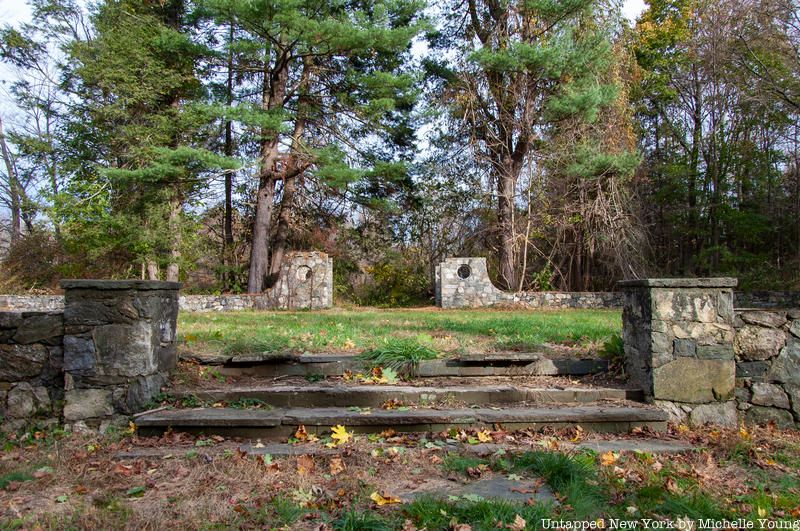
Closest to the Taconic Parkway, there are several stone steps leading up to a more terraced expanse of grass surrounded by stone walls on three sides. On one wall, you can find a stone archway closed up with brick and stone, featuring what’s left of a fountain coming out of the wall.

Placed in alignment with the stone steps are two stately stone entrance structures that were clearly the main architectural element. If you kick away the bed of pine needles on the ground here, you’ll find old brick and stone tiles. Take the overgrown path from here, and you’ll come upon an abandoned tennis court.
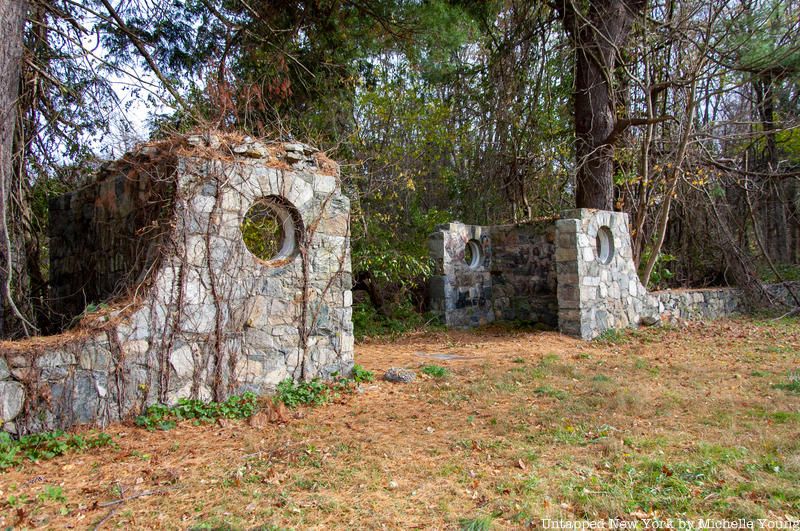



There are no buildings left today, but if you look at satellite images in Google Earth, you can see some of the structures that used to be on the property. A collection of barns once existed where the parking lot now is located, which you can see in more detail via a street view image from 2008. Behind these buildings was a rectangular pool and pool house. Very little else is documented about French Hill Farm, but to our great delight, The Yonkers Herald did include a few photographs of the property in an article about Baldwin’s death in 1930. These photos were key in how we identified where the main house was once located.
The caption of the photograph describes a “pretty,” “low rambling cottage” with a “flower-bordered flagged pathway” that “leads to the main door of the home.” The same stone pathway is shown leading away from the house to “the flower gardens, now in full bloom.” There appear to be even larger stone structures along the north wall of the garden, now lost. The bottom right photo from The Yonkers Herald shows the rectangular “private swimming pool.” The cottage was therefore located close to the walled gardens. A US Geological Survey satellite image from 1993 shows a white house with dormer windows located between the barns and the garden. By 2004, the house has been demolished but the barns, pool and tennis court are still there.
 1994 Image from U.S. Geological Survey, April 2004 image © 2020 New York GIS, June 2019 image from Google Earth. GIF by the author.
1994 Image from U.S. Geological Survey, April 2004 image © 2020 New York GIS, June 2019 image from Google Earth. GIF by the author.
As of April 2007, the property overall looks to be in in pretty decent condition but by 2010, the pool house and pool are overgrown. By 2014, the barn structures are clearly decaying. In April 2016, the pool is in the process of being dug up. Sometime after that, all the structures on the property are demolished and by May 2018, the newly paved parking lot is in place.

Baldwin had a love for the great outdoors, serving as the first president of the Westchester County Park Commission and was a member of the Adirondack League. Baldwin also donated more than 25 acres of French Hill Farm for the construction of the Taconic Parkway (then called the Bronx River Parkway extension), which you can now see clearly from the garden. “In late years a resident of Westchester County, Mr. Baldwin became interested in the development of parks and highways,” reports The Yonkers Herald. As the president of the Westchester County Park Commission, Baldwin was also involved in the design and construction of the Hutchinson Parkway, the Saw Mill River Parkway, numerous waterfront parks along the Hudson River and Long Island, and with the creation of Glen Island in New Rochelle. He was a veritable pre-Robert Moses like figure and a plaque dedicated to him is affixed to a boulder along the Taconic Parkway, not far from his former estate. Like many other wealthy New Yorkers of his time, he was also a member of numerous private clubs, including the National Arts Club, the Metropolitan Club, the Bankers Club (atop the Equitable Building), India House, and the Union League.


Baldwin died at his home at French Hill in 1930 suddenly of a heart attack at the age of 74. He had just returned from a funeral in Ohio and spent the evening talking with his son. The funeral service was held at his home, led by someone from the Second Church of Christ Scientist in Manhattan on Central Park West. So many mourners wanted to attend his funeral that an additional car was attached to the train that left from Grand Central to Peekskill at 2:04 PM on September 29, 1930. He was cremated and then buried in a relatively simple grave at Green-Wood Cemetery in Brooklyn in a plot for the Sullivans, the family of his wife.
Donald J. Trump State Park is not quite as trashy nor as run-down as previously reported in other media outlets, with some upkeep in the park clearly having taken place this year. The two sections of Donald J. Trump State Park are very different from each other, although both were formerly farmland. Neither have any amenities or have been designed for active public use, though passive use has been allowed despite the park being officially closed. Both are maintained at the bare minimum, although some improvements are planned for the Indian Hill section. Without any historical signage to denote its past, the French Hill section holds several centuries of hidden history from the American Revolution through the Gilded Age and the Roaring ’20s. Today, as we anticipate the results of the U.S. Presidential election, we wonder what will become of Donald J. Trump State Park in the future.
Next, join a Hudson River Valley lighthouse tour and fall foliage tour and check out 10 Must-Visit Places in Dutchess County.
Subscribe to our newsletter